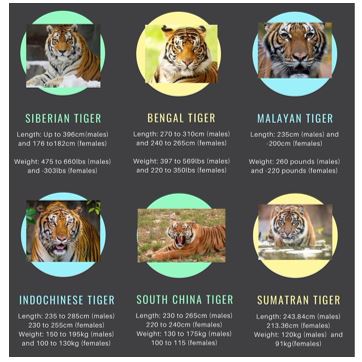

29th July 2022 (7 Topics)
Context
As the world observes International Tiger Day on July 29, there is need to look at the declining trend of tiger population (1,059 tigers have been lost since 2012)
About
The Species
- Ttiger, (Panthera tigris) is the largest member of the catfamily (Felidae).
- In the wild, tigers are found in India, Nepal, China, Russia, Bhutan, Myanmar, Cambodia, Laos, Vietnam, Thailand, Sumatra (Indonesia) and Malaysia.
The five surviving sub species of tiger are
- Indian Tiger or Royal Bengal Tiger(Panthera tigris tigris) found in India, Nepal, Bhutan and Bangladesh;
- Indo-Chinese tiger(Panthera tigris corbetti) mainly found in Thailand and Peninsular Malaysia but are also found in Myanmar, Southern China, Cambodia, Laos and Vietnam;
- Siberian or Amur Tiger(Panthera tigris altaica) found in far east Russia;
- Sumatran Tiger(Panthera tigris sumatrae) found in the Indonesian island of Sumatra;
- South China Tiger(Panthera tigris amoyensis) found in China. The population found in Peninsular Malaysia has been given a status of separate sub species Panthera tigris jacksoni.
- The three sub species of tigers that became extinct in the past century are:
- the Bali Tiger (Panthera tigris balica)
- the Javan Tiger (Panthera tigris sondaica)
- the Caspian Tiger (Panthera tigris virgata)
Recent reports indicate that the South China tiger is also extinct in the wild.
Why Tigers were important to be conserved?
- Important role in the health and diversity of an ecosystem.
- An indicator of the well-being of the ecosystem.
- It is a top predator which is at the apex of the food chain and keeps the population of wild ungulates in check, thereby maintaining the balance between herbivores and the vegetation upon which they feed.
- The extinction of this top predator is an indication that its ecosystem is not sufficiently protected, and neither would it exist for long thereafter.
|
Protection given to Tigers
|
What are the Methods used to estimate their population?
Data collection is required to know where conservation efforts and resources need to be applied. To collect such data, techniques such as radio collars and capture-recapture population estimation models have been used to collect population numbers.
- The pugmark census technique: is also used during travels along the tiger dominated places. This involves observing paw prints in the ground and taking measurements of width, length and indentation to determine the individual that was in the location.
- Using Traditional Methods: Dogs are also used to assist tracking the tiger by smell. Once the tigers are found, photographs, drawings and notes regarding sex, location, and other details of the individual are taken and sent back to the study camp.
- Using Camera Traps: It involves setting up surveying cameras that activate when there is movement detected and will spontaneously take multiple photographs of the area.
- Capture-recapture models; are now commonly used in conjunction with tiger tracking.
- They not only measure population numbers, but also measure demographic parameters.
- This combination technique consists of camera traps and basic tiger search to collect sufficient data.
- Once researchers and conservation biologists are able to gain knowledge of the population and its numbers, conservation efforts are put to work.
Factors Determining Tiger Conservation
Factors determining success of Tiger conservation generally includes;
- Size of protected area
- Biodiversity in the environment
- Number of tigers in the area
- Connectivity of the area to buffer zones
- Funding and Community Support
What are the loopholes in conservation practices?
- Mitigation Conflicts: In densely populated countries like India availability of sufficient exclusive space to maintain viable populations of large carnivores is difficult and coexistence becomes an essential strategy for effective conservation.
- Human- Wildlife conflict is the one of the reason for sustainable Tiger Habitats.
- Illegal Trade of Tigers: International market demand for tiger body parts, the incentive for poaching of tigers remains.
- Therefore, enforcement of law through patrols on the ground, use of modern technology that helps in apprehension of poachers, recording evidence that would stand the scrutiny of the legal process and result in conviction, are all equally important.
- Technological drawbacks: Use of technology such as the E-eye, a sensor-based system of thermal and visual cameras deployed along some sensitive borders of high-profile tiger reserves relayed real-time surveillance to tiger reserve managers and acted as major deterrent for poachers.
- Lack of Policy implementation: Due to the less number of people employed in the staff for surveillance and protection in Tiger reserves, a trained and professional staff is required.
- This affects the policy implementation.
Some Government Initiatives
- Project Tiger: Project Tiger aims at tiger conservation in specially-constituted tiger reserves, which are representative of various bio-geographical regions in the country.
- It strives to maintain viable tiger populations in their natural environment. As of 2019, there are 50 tiger reserves in India, covering an area of 37,761 km2(14,580 sq mi).
- The Wildlife (Protection) Act 1972 is a very powerful legislation.
- It provides for penalties of 3–7 years of imprisonment and/or fine of INR 5,000 to 200,000 for the poaching of tigers.
- National Tiger Conservation Authority: National Tiger Conservation Authority (NTCA) is a statutory body under the Ministry of Environment, Forests and Climate Change.
- It was established in 2005 following the recommendations of the Tiger Task Force.
- It was constituted under enabling provisions of the Wildlife (Protection) Act, 1972, as amended in 2006, for strengthening tiger conservation, as per powers and functions assigned to it.
More Articles




